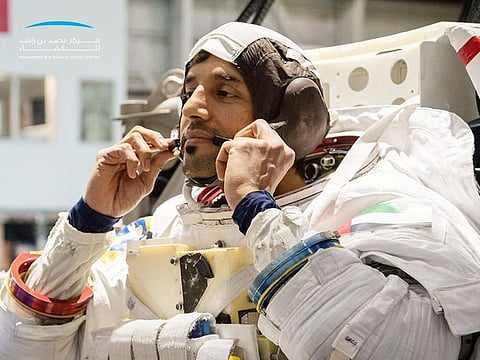From 'gorilla sitting on chest' to 16 sunsets 'in a day', quirky space experiences await UAE astronaut Sultan Al Neyadi
Here are some facts and figures that will be part of astronauts’ unusual life on ISS

Dubai: From feeling a giant gorilla sitting on chest to seeing 16 sunsets and 16 sunrises every day, several quirky space experiences await UAE astronaut Sultan Al Neyadi who is set for lift-off on Monday.
First off, the International Space Station (ISS), his residence for the next six months. The habitable artificial satellite travels through space at 17,500 miles or 28,000 kilometres per hour at an altitude of about 220 to 250 miles (around 400km).
Al Neyadi is part of NASA’s SpaceX Crew-6 mission, set for lift-off at 10:45am UAE time on Monday (February 27) to the ISS, the largest human-made object in space.
45-minute 'day'
It orbits the Earth about once every 90 minutes. During the orbit of the Earth, astronauts on board are in daylight for about 45 minutes and darkness for about 45 minutes.
There are approximately 16 orbits per day (in 24 hours). That means the astronauts aboard ISS can witness 16 sun rises and 16 sun sets every day.
Al Neyadi’s Crew-6 mission is slated to last for six months or 182 days, subject to the requirements of the mission.
If he stays that long on ISS, he will have the opportunity to witness 2,912 sunrises and as many sunsets.
Long flight
It can take anywhere from six hours to three days to get to the space station, depending on the spacecraft and mission profile.
SpaceX Falcon 9 rocket will accelerate Crew-6 Dragon ‘Endeavour’ to an orbital velocity of 17,500 mph prior to spacecraft separation and rendezvous (approaching ISS at close distance).
As of publication time, the Crew-6 mission is expected to dock into ISS at 11:38am UAE time on Tuesday. That means Al Neyadi’s flight will last for at least 24 hours and 53 minutes to reach ISS.
Unusual experiences
According to NASA, the unusual life of astronauts, in fact, begins from the time they board the launch vehicle. Here are some facts that will be part of the experiences that await Al Neyadi during the UAE’s Mission 2, the longest space expedition by an Arab:
Shortly before the time of launch, astronauts start hearing different noises below and they feel a giant beast is waking up.
As they move up and away from the launch pad, speed builds up very quickly and the G-load, or the force of gravity or acceleration on a body, increases.
Eight and a half minutes after launch, there is a loud bang and jerk and the last section of the rocket is jettisoned from the spacecraft. That is when astronauts reach space and they will feel like they are hanging upside down in their shoulder harness.
'Gorilla on chest'
“As you get higher into the thinning atmosphere and burn off most of the fuel, the vehicle accelerates faster and you are pressed back into your seat with three times your weight for the last two and a half minutes of the ride. This two-and-a-half G’s feels like a giant gorilla is sitting on your chest, making it more difficult to breathe. Eight and a half total minutes after liftoff, the main engines stop and immediately, you go from the being squashed by the gorilla to being weightless,” explains NASA.
The space station has the volume of a five-bedroom house or two Boeing 747 jetliners. On Earth, the space station would weigh almost a million pounds. Measured from the edges of its solar arrays, the station covers the area of a football field including the end zones.
Body’s reaction to micro-gravity
A ‘normal’ body will adapt to the ‘abnormal’ environment of space in many ways. Immediately upon entering 'zero gravity', fluids in your legs and the lower part of your body move upwards towards your head. In fact, your face will feel and look swollen.
Except for the occasional headache and congestion, astronauts are not bothered by this fluid shift. Some astronauts feel dizzy and have an upset stomach during the first few days of a space flight as they get used to zero gravity. This feeling usually goes away after three or four days. After a few days, almost everyone is used to zero gravity and feels great. If they do not exercise, their bones and muscles will get weak.
About food... and toilets
There is no freezer, refrigerator, stove or microwave on the ISS. Most of the food for astronauts has already been cooked, then freeze-dried and vacuum-packed (meaning the water and air has been taken out of it), or it is thermally stabilised (meaning treated and sealed in a package to prevent spoiling), much like camping food. These packages of freeze-dried food can be reconstituted by adding water and then warmed up in a small warming oven.
Al Neyadi has said he will carry some Emirati delicacies and will share them, especially dates, with his colleagues on board ISS during Ramadan.
The space toilet is a little different than the Earth toilet. It uses suction, not water, to ‘flush.’ To keep from floating away, astronauts must use foot-loops or straps while ‘sitting’ on the seat. This holds them on to the seat, sort of like a seat belt.
Sign up for the Daily Briefing
Get the latest news and updates straight to your inbox

